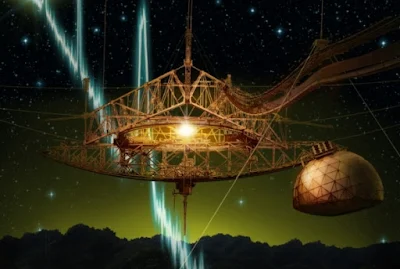Οι
επιστήμονες αναζητούν εναγωνίως την πηγή των παράξενων κοσμικών «σημάτων» που
έφτασαν στη Γη. This artist's rendition shows a millisecond pulse of
radio waves, a "fast radio burst" from an unknown astrophysical
source, streaming into the giant Arecibo telescope out of a starry sky. Using
Arecibo, researchers have for the first time witnessed a fast radio burst
repeat, coming one step closer to solving the mystery of the bursts' cosmic
origins. Credit: Danielle
Futselaar
Οι
αστρονόμοι για πρώτη φορά εντόπισαν «γρήγορες εκλάμψεις ραδιοκυμάτων» (Fast Radio Bursts-FRB), οι οποίες ήσαν επαναλαμβανόμενες. Φαίνεται να προέρχονται
από μια κοινή αινιγματική πηγή πολύ πέρα από τον γαλαξία μας. Μέχρι σήμερα οι
επιστήμονες είχαν ανιχνεύσει τέτοιες σπάνιες ραδιο-εκρήξεις ως συμβάντα «μια κι
έξω» και ποτέ ως επαναλαμβανόμενα φαινόμενα. Οι επιστήμονες αναζητούν τώρα την
πηγή των «σημάτων» αυτών και μέχρι να δοθεί απάντηση οι θεωρίες θα είναι πολλές
και φυσικά κάποιοι θα αναφέρουν ότι πρόκειται για προϊόν προηγμένου εξωγήινου
πολιτισμού.
Ο εντοπισμός
Για
πρώτη φορά εντοπίζονται επαναλαμβανόμενα ραδιοκύματα FRB. An international research team used a
combination of radio and optical telescopes to identify the precise location of
a fast radio burst (FRB) in a distant galaxy, allowing them to conduct a unique
census of the universe's matter content. Their result confirms current
cosmological models of the distribution of matter in the universe. The infrared
image on the left shows the field of view of the Parkes radio telescope with
the area where the signal came from marked in cyan. On the right are successive
zoom-ins on that area. At the bottom right is the Subaru optical image of the
FRB galaxy, with the superimposed elliptical regions showing the location of
the fading 6-day afterglow seen with ATCA. Credit: © D. Kaplan (UWM), E. F.
Keane (SKAO)
Ερευνητές
από διάφορες χώρες, με επικεφαλής τη Λάουρα Σπίτλερ του γερμανικού Ινστιτούτου
Ραδιο-Αστρονομίας Μαξ Πλανκ στη Βόννη, ανέφεραν ότι η πηγή του φαινομένου
πρέπει να είναι κάποιο υπερβολικά ισχυρό αντικείμενο, που περιοδικά παράγει
τέτοιες ραδιο-εκρήξεις σε διάστημα μικρότερο του λεπτού.
This image shows
the increased delay in the arrival time of the Fast Radio Burst as a function of
the frequency. The delay in the signal is caused by the material it goes
through between its point of origin and Earth. Image Credit: E. F. Keane (SKAO).
Οι
εκλάμψεις FRB,
που διαρκούν ελάχιστα χιλιοστά του δευτερολέπτου αλλά είναι πολύ ισχυρές,
προβληματίζουν τους επιστήμονες. Για πρώτη φορά εντοπίσθηκε μια τέτοια «έκρηξη»
πριν περίπου δέκα χρόνια, αλλά παραμένει άγνωστο τι τις προκαλεί. Έχει προταθεί
ως εξήγηση η έκρηξη ενός υπερκαινοφανούς αστέρα (σούπερ-νόβα), η βαρυτική
κατάρρευση ενός αστέρα νετρονίων (πάλσαρ) σε μια μαύρη τρύπα ή μια έκρηξη
ακτίνων-γάμα.
Όμως
η ανακάλυψη επαναλαμβανόμενων σαν φλας FRB για πρώτη φορά από το ραδιοτηλεσκόπιο
Αρεσίμπο στο Πουέρτο Ρίκο -το μεγαλύτερο ραδιοτηλεσκόπιο στον κόσμο, με
διάμετρο 305 μέτρων- περιπλέκει τα πράγματα και αναζητάται πλέον μια πιο
«εξωτική» πηγή προέλευσης. Η ανακάλυψη δημοσιεύεται στην επιθεώρηση «Nature».
Πηγή:
Nature, DOI: 10.1038/nature17140




Δεν υπάρχουν σχόλια:
Δημοσίευση σχολίου